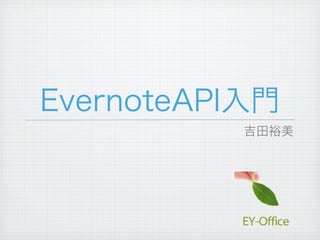·¡±¹±ğ°ù²Ô´Ç³Ù±ğ´¡±Ê±õÈëÃÅ
- 2. 2
- 3. 3
- 4. 4
- 5. 5
- 6. 6
- 7. 7
- 9. 9
- 10. 10
- 11. 11
- 12. 12
- 13. 13
- 14. 14
- 15. 15
- 16. 16
- 17. 17
- 19. EDAM¡¯s remote procedures are divided into two remote services: the UserStore service, which is used by local applications to authenticate users, and the NoteStore, which authorized applications use to access and change data in user accounts. EDAM clients communicate with these two services as shown in the following diagram: Evernote Service Note Processing shard n shard 1 shard 2 ¡ (Image recognition, etc.) OAuth Note User Service Store Store Provider EDAM API via Thrift OAuth protocol Evernote for Evernote for Evernote for Third party desktop Third party web OS X Windows Mobile application service 19
- 20. The following diagram shows the high-level relationships between the core data elements managed by the Evernote service for each subscriber. This shows the major data structures and key fields for each of those structures. The full documentation for each structure and field is found inline within the Thrift IDL files. 1 N Notebook 1 Publishing User guid 1 uri id name publicDescription username updateSeqNum ¡ privilege 1 email N ¡ Tag 1 shardId guid ¡ name 1 1 updateSeqNum N N 1 parentGuid Note guid 1 1 N 1 N title 1 NoteAttributes content latitude Accounting active longitude uploadLimit updateSeqNum sourceURL uploadLimitEnd ¡ ¡ N 1 ¡ N 1 SavedSearch Resource guid UserAttributes guid name 1 ResourceAttributes incomingEmail query data referrerCode mime 1 latitude updateSeqNum longitude dailyEmailLimit ¡ data ¡ recognition cameraMake updateSeqNum fileName ¡ ¡ The structures on the left side of the diagram (User, Accounting, UserAttributes) are 20 interchanged via the UserStore service, while the ones on the right are exchanged via
- 21. 21
- 22. 22
- 23. 23
- 24. 24
- 25. 25
- 26. 26
- 27. 27
Editor's Notes
- \n
- \n
- \n
- \n
- \n
- \n
- \n
- \n
- \n
- \n
- \n
- \n
- \n
- \n
- \n
- \n
- \n
- \n
- \n
- \n
- \n
- \n
- \n
- \n
- \n
- \n
- \n
- \n




























